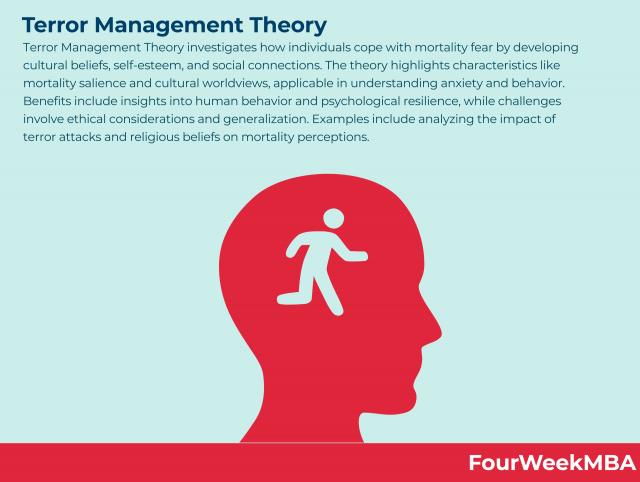Terror Management Theory investigates how individuals cope with Mortality fear by developing cultural beliefs, self-esteem, and social connections. The theory highlights characteristics like mortality salience and cultural worldviews, applicable in understanding anxiety and behavior. Benefits include insights into human behavior and psychological resilience, while challenges involve ethical considerations and generalization. Examples include analyzing the impact of terror attacks and religious beliefs on mortality perceptions.
Related Articles
Characteristics:
- Mortality Salience: At the core of TMT lies the concept of mortality salience—the heightened awareness of one’s own mortality. This awareness can trigger existential anxiety, which, in turn, drives various psychological processes and behaviors.
- Cultural Worldviews: TMT emphasizes the development of cultural beliefs, values, and worldviews as a means of managing mortality concerns. Individuals seek cultural systems that provide a sense of meaning and continuity beyond their own lifetimes.
- Self-Esteem: Elevating self-esteem is another coping mechanism posited by TMT. By boosting their self-esteem, individuals aim to create a psychological buffer against the fear of death, as high self-esteem can serve as a defense mechanism against existential anxiety.
- Social Connections: Building strong social connections and bonds with others is a key aspect of TMT. These connections offer comfort and support, both in terms of managing existential fears and in upholding cultural worldviews.
Use Cases:
TMT finds application in various areas of psychology and sociology:
- Understanding Anxiety and Fear: TMT provides a lens for understanding how humans manage existential anxiety and fear, which are inherent aspects of the human experience. It explores how these fears influence beliefs, behaviors, and social interactions.
- Coping Mechanisms: TMT sheds light on the development of psychological defense mechanisms in response to mortality concerns. It offers insights into why individuals adopt specific coping strategies and how these strategies manifest in their lives.
- Cultural Impact: The theory assesses the influence of cultural beliefs and systems on human behavior. It examines how cultural worldviews are constructed and how they function as a source of meaning and security in the face of mortality.
Benefits:
The study of Terror Management Theory offers several advantages:
- Insights into Human Behavior: TMT provides profound insights into how mortality fears shape human attitudes and actions. It helps explain why individuals are drawn to certain cultural beliefs, why they seek self-esteem, and why they value social connections.
- Psychological Resilience: Understanding the coping mechanisms for fear and anxiety, as posited by TMT, can aid in developing psychological resilience. This knowledge can be valuable in therapy and mental health interventions.
- Cultural Analysis: TMT’s exploration of cultural systems and their influence on human psychology enables researchers to analyze cultural dynamics, including the role of religion, rituals, and societal norms in managing existential concerns.
Challenges:
However, the study of Terror Management Theory also presents challenges:
- Ethical Concerns: Research in this field may raise ethical concerns, particularly when investigating sensitive topics related to mortality, fear, and belief systems. Ensuring the ethical treatment of research participants is paramount.
- Cultural Differences: TMT’s applicability and relevance may vary across cultures. Different cultures have distinct ways of managing existential anxiety, and researchers must be sensitive to these cultural variations.
- Generalization: Applying findings from TMT research to diverse human populations can be challenging. Cultural, demographic, and individual differences may limit the generalizability of research results.
Examples:
To illustrate Terror Management Theory in action, consider the following real-life examples:
- Terror Attacks Impact: The psychological effects of terrorist events, such as the 9/11 attacks, highlight the role of mortality salience. These events can trigger heightened awareness of mortality and lead individuals to seek comfort and security in cultural and social bonds.
- Religious Beliefs and Mortality: Religious convictions often provide existential comfort by offering beliefs in an afterlife or a higher purpose. Individuals who hold strong religious beliefs may experience reduced existential anxiety in the face of mortality.
- Mortality Salience and Behavior: Studies have examined how awareness of mortality influences decision-making. For example, individuals reminded of their mortality may make choices that align with cultural values or seek self-esteem boosts through achievement.
Terror Management Theory: Key Highlights
- Definition: Terror Management Theory investigates how individuals cope with mortality fear by developing cultural beliefs, self-esteem, and social connections.
- Characteristics:
- Mortality Salience: Recognition of mortality triggers existential anxiety.
- Cultural Worldviews: Developing cultural beliefs to provide meaning and security.
- Self-Esteem: Elevating self-esteem to buffer against mortality concerns.
- Social Connections: Building strong social bonds for comfort and support.
- Use Cases:
- Understanding Anxiety and Fear: Exploring how humans manage existential anxiety and fear.
- Coping Mechanisms: Examining how individuals develop psychological defenses.
- Cultural Impact: Assessing the influence of cultural beliefs on behavior.
- Benefits:
- Insights into Human Behavior: Understanding how mortality fears shape attitudes and actions.
- Psychological Resilience: Gaining insights into coping mechanisms for fear and anxiety.
- Cultural Analysis: Analyzing cultural systems and their influence on human psychology.
- Challenges:
- Ethical Concerns: Addressing potential ethical implications in research.
- Cultural Differences: Recognizing variations in fear management across cultures.
- Generalization: Applying findings to diverse human populations.
- Examples:
- Terror Attacks Impact: Studying the psychological effects of terrorist events.
- Religious Beliefs and Mortality: Exploring how religious convictions provide existential comfort.
- Mortality Salience and Behavior: Examining how awareness of mortality influences decision-making.
Connected Thinking Frameworks
Convergent vs. Divergent Thinking
Critical Thinking
Biases
Second-Order Thinking
Lateral Thinking
Bounded Rationality
Dunning-Kruger Effect
Occam’s Razor
Lindy Effect
Antifragility
Systems Thinking
Vertical Thinking
Maslow’s Hammer
Peter Principle
Straw Man Fallacy
Streisand Effect
Heuristic
Recognition Heuristic

